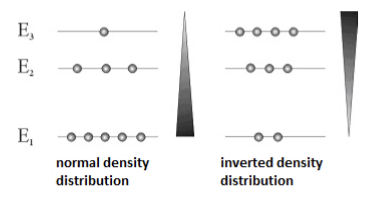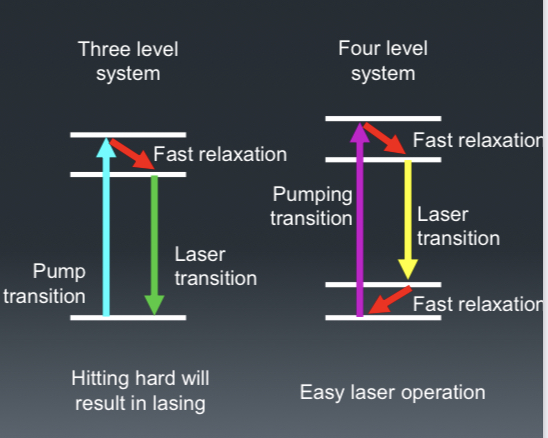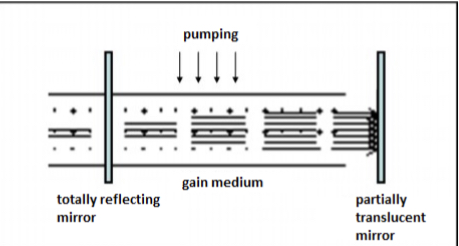The Laser
LASER - Light amplification by stimulated emission of radiation
Creation of LASER
Absorption: When electrons in the ground state absorb a photon with certain energy then it can move to a higher state, if the energy difference between ground and excited state is same as photons energy.
(Bohr’s resonance condition; E2-E1=hf).
Spontaneous emission: The electron goes back to the ground state after some time and emits a photon of defined energy. All without outside impact.
Stimulated emission: Einstein predicted that we could induce emission, when a photon with energy that satisfies Bohr’s condition for electrons in excited state is emitted by electron in excited state.
The emitted photon has same energy, frequency, direction, phase and polarization as the outside photon so photon number is doubled.
Einstein realized that from one photon two is gotten so we can amplify light.

Population inversion: To get a high intensity light we need to create a lot of numerous excited electrons in a material then invest energy from outside into the material (laser pumping). If electron number in ground state is N1 and excited state is N2 then we have N1>>N2 but if we are pumping it is N2>N1, if the number of excited electrons is higher than ground state electrons that is population inversion.

Laser pumping can be achieved by; thermal excitation (warming), optical excitation (with flashlight) and electric discharge.
Energy levels of a LASER
• Three level system; electrons undergo pump transition from ground state to excited state E3 and then fast relaxation to E2 then laser transition back to ground state. This works only if ground state is depopulated.
Example: Ruby laser, the medium is chromium doped synthetic sapphire.
• Four level system; electrons undergo pump transition from ground state to excited state then fast relaxation to E3 and laser transition to E2 then fast relaxation back to ground state.
Example: He-Ne laser, between 7:1 - 10:1 mixture of helium to neon.

Metastable state is a short-lived high-energy state that spontaneously drops to a lower-energy state with an unusually long lifetime.It thousands the excitation energy, E3 is the metastable state.
Laser oscillator
Need: gain medium, intensive electron excitation, positive feedback and optical resonator.

Resonance condition: 2L= m(wavelength)
L is distance between mirrors, m is integer. The natural vibrations are standing waves.
Properties of LASER
- Monochromatic: narrow bandwidth.
- Coherent: create interference even in big path differences.
- Collimated: narrow beam with little divergence.
- Power density: has higher power density (E/At)
- Polarized: ultrashort pulses.
Categories of LASERS
By gain medium; semiconductor, gas, solid state and dye lasers.
By operation; continuous wave and pulsed lasers.
By energy; class I, II, III, IV.
Difference between pulsed lasers and continuous wave
Pulsed lasers produce a series of pulses at a certain width and frequency until stopped. It allows for determination of excited state lifetimes.
Continuous wave has constant output over an interval of seconds.
Pulsed Lasers: they operate at frequency between 15Hz - 100MHz and pulse length between ns - fs
Example; Q-switched Lasers which maximise population in ration and switch out a large pulse. Pulse length of 100 - 200ns . They are used in Tattoo removal.
Medical application
- Surgical operations
- Retinal laser surgery
- Gene surgery